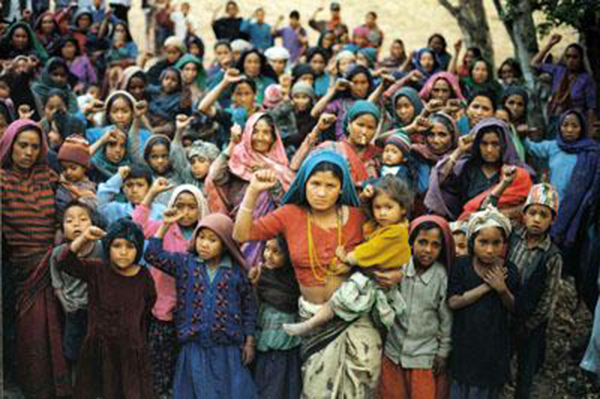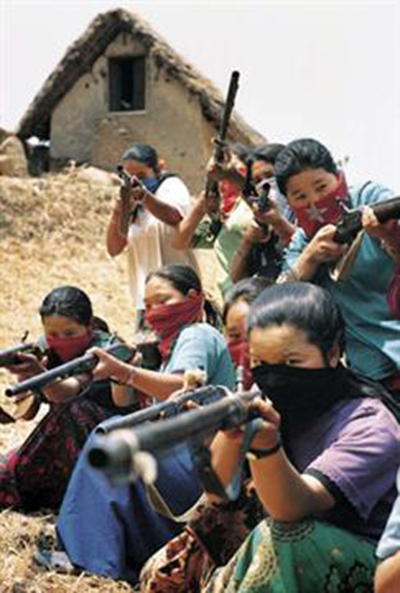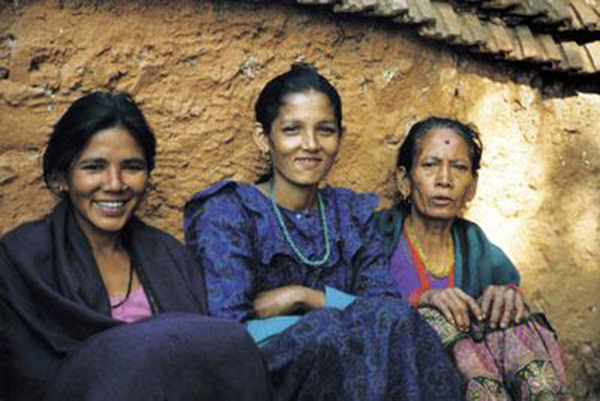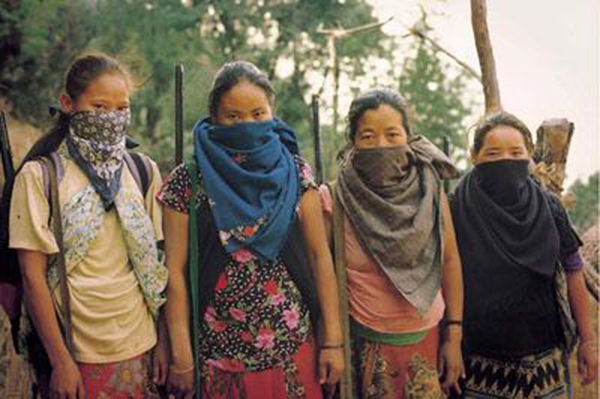Child Brides and Sex Trafficking in Nepal: Hypocrisy of the New York Times
by Li Onesto
| revcom.us
Editors’ Note: Revcom.us received the following correspondence from Li Onesto, who traveled deep into the guerrilla zones of Nepal during the People’s War in 1999, and is the author of the book Dispatches from the People’s War in Nepal.
A recent New York Times article reports that in Nepal, child marriage has been increasing at alarming levels, that COVID-19 has made this situation even worse, and that there’s a link between marrying young and dying young.1 The Times has also run articles exposing how thousands of young women, trafficked out of Nepal, have ended up being forced to work in brothels in India.2 All of this is true—and it is horrific and utterly unnecessary.3
But there is rank hypocrisy here. Because there was a time, in fact, when the masses of people in Nepal took up a radical and revolutionary struggle against these horrific ways women are oppressed, aiming to get beyond these outrages—and the Times, along with others in the mainstream bourgeois press, viciously slandered that struggle, spreading disinformation to rally public opinion against the revolution in Nepal, as the U.S. government moved to attack and repress the revolution along with other reactionary powers like India.
In the 1990s, a Maoist People’s War in Nepal, centered in the rural villages, went up against the whole history of imperialist domination and feudalism. This was a genuinely liberatory revolutionary struggle even as it had shortcomings.4 Unfortunately for a number of reasons, this revolution went off course and the liberating and revolutionary advances it had achieved were seriously set back, and the reversals manifest in some of the horrors today.5 But while this People’s War was going on, a central aim of this revolution was fighting the oppression of women, including ending things like child marriage and the trafficking of women.


Photo: Li Onesto
When I traveled through the guerrilla-controlled areas of Nepal in 1999, I saw how the liberation of women was a vital part of this revolution and how so many women surged to the frontlines of this struggle. I interviewed women and men who described how, when the armed struggle started, it was like the opening of a prison gate—with thousands and thousands of women rushing forward to claim an equal place in the war. Some had to defy fathers and brothers. Some had to leave backward-thinking husbands. Others ran away from arranged marriages where parents had decided their fate. They all had to rebel against feudal traditions that treated women as inferior, that made women feel like their ideas didn’t matter. I heard stories of how the rebels were combating domestic violence and rape, how for the first time, women were free to get divorced in the areas liberated by the People’s War, and how they were not only allowed but actually encouraged to go to school. Most inspiring, I saw how many women, both young and old, had found new freedom, raising sights to a whole different future, joining the People’s War to overthrow the corrupt and oppressive government.6

Photo: Li Onesto
Slanders and Lies from the “Liberal” Media
But at the time, and in stark contrast to this living reality, what did the New York Times say and “report” about the People’s War in Nepal? What did it have to say about a revolution that was fighting feudalism, patriarchy, and imperialism—which was then and are now driving forces behind oppressive traditions like child marriage and the trafficking of women?

Photo: Li Onesto
The Times lied about and slandered this revolution, consistently and repeatedly. They acknowledged the corrupt and oppressive nature of Nepal’s government but called the struggle to overthrow it “a crippling ‘people’s war.’”[Emphasis added]7 They repeated the lie that the rebels were guilty of “gruesome” human rights violations, describing a situation where “villagers hid their weeping children under beds” because they feared “the Maoists will return.”8
It called the People’s War a “criminal enterprise” guilty of kidnapping, extortion, forced conscription, and the use of child soldiers. And blamed the rebels for killing thousands of people—blurring the fact that government soldiers were most responsible for civilian deaths, for torturing those it suspected of being rebels and for raping women.9 This was a revolutionary civil war where government forces and reactionary forces mobilized by the government and their supporters were killed in battle. The New York Times along with some liberal human rights groups drew a broad brush in labeling such actions “human rights abuses” and “torture.” The vast majority of people killed by the Maoists were police and soldiers in combat. And when others, like informants, were targeted, it was because their actions directly led to Maoists and others being jailed, tortured, or killed. The New York Times applied odious analogies of the Maoists as a “creeper wrapping itself around a tree” because they used “entrenched poverty and discrimination of this Hindu kingdom’s deeply feudal society to build its insurgency,”10 as opposed to any sense of a righteous revolution against all this. In reality, the Maoists gained widespread support exactly because they were about putting an end to the outdated monarchy, the discriminatory caste system, and the feudal/capitalist system that kept the people in deep poverty.
The “liberal” Harper’s magazine, which also writes about women’s equality, also attacked the People’s War in Nepal. In a major article in 2005, Eliza Griswold acknowledged the rebels controlled 73 of the 75 political districts, then quotes a man saying, “99 percent of the country don’t like the Maoists,” as if this was a fact, with no mention of the widespread support, or any degree of refutation. This is a standard method of disinformation and slander used by the mainstream media: quote a backward person, with this “first-person” account creating public opinion in the context of and reinforcing their dominant “narrative”—for that’s what it was, a slanderous “narrative” largely at odds with reality. Starting out very small, how could the rebels have grown like this without the genuine support and participation of people throughout the countryside? Griswold says they did it through coercion and terror. But in fact, this is plainly untrue, even while there were real shortcomings. They worked to win people to their cause and in areas they controlled real changes were made reflecting their liberatory goal of getting rid of inequality and oppression. They did not torture captured soldiers and instead released many of them, in good health to the Red Cross or other human rights organizations. Released soldiers reported they had to “listen to propaganda” and were asked to join the revolution, but weren’t harmed. The rebels told them they would be punished if they kept fighting for the reactionary government and were then given money and food to go back to their villages instead of returning to the army.11
The Role of the Liberal Media
“Mainstream, liberal” institutions like the New York Times and Harper’s serve a very important role as part of and in defending the capitalist/imperialist system, and the role of the U.S. competing for dominance atop this system. At times, they do real exposure of some of the “problems” of this system and society, voicing concern and hope that such oppression can be made more “bearable.” But this is constrained by and within the confines of maintaining, and never fundamentally questioning, the underlying system of capitalism-imperialism or the role and nature of the U.S., even if there is some exposure of the visible economic, political, and social effects of the workings of this system and the history of this country.
These are, as Bob Avakian says, “crude propaganda organs of the ruling class posing as news media. These are not just, as it is sometimes said, corporate or corporate-controlled media. They are propaganda instruments of the ruling class of this system—capitalist-controlled, imperialist-controlled media” and they play a crucial role in why and “how people are kept deliberately uninformed or systematically misinformed and miseducated under this system.” (Emphasis added.)
For these “liberal” voices, when a revolutionary force comes along like the People’s War in Nepal that actually threatens the system and the foundation of the relations of exploitation and oppression, the slanders and distortion come spewing out, almost on cue and on message, like an orchestra with its different instruments, but all playing the same song. Even reporters who may have good intentions, who genuinely want to see oppression mitigated, find this clashing with their petit bourgeois outlooks, making them recoil at a real revolutionary solution that requires actually overthrowing the present setup, fearing its radical nature, its upheaval and chaos involved in forging a radically new and better social order on the road to genuine emancipation.
The New York Times sets the tone for national public opinion, not only for millions of readers influenced by it, but for other media outlets as well. And in an ongoing way, the Times trains people in what and how to think and approach the world—including instilling the notion that “while there might be things wrong with the system, this is still the best of all possible worlds.” The New York Times and other mainstream media, in fact, helped ensure that most people, at least in the U.S., remained unaware there was an inspiring, liberating People’s War in Nepal—and that if they did know anything about it, this was based on a reeking vat of slanders and lies.
1. “In Nepal and Across the World, Child Marriage Is Rising,” by Bhadra Sharma and Jeffrey Gettleman, New York Times, March 8, 2021. [back]
2. “Women, Bought and Sold in Nepal,” by Katie Orlinsky, New York Times, Aug. 31, 2013. [back]
3. For more on this, see the excerpt from an interview by Sunsara Taylor with Indian journalist Ruchira Gupta, featured in episode 44 of The RNL—Revolution, Nothing Less—Show. [back]
4. The revolutionary People’s War in Nepal, led by the then Communist Party of Nepal (Maoist) was launched in 1996, and by the early 2000s, had grown to control most of the countryside. By 2005, they were approaching the threshold of and grappling with nationwide seizure of power, with influence in the main cities, including the capital, Kathmandu, with larger middle-strata of people—and all this posed major new challenges, including threats of armed intervention from India, the U.S. and other reactionary powers against the revolution and the masses of Nepal. In the face of these challenges, interrelating with and exacerbating existing shortcomings and weaknesses in line, method and approach, the Communist Party of Nepal (Maoist) started going seriously off-track in 2005-2006, eventually ending up abandoning the revolutionary goal altogether a few years later, a very negative development for humanity.
For more on this, and the lessons on communist leadership, we highly recommend Bob Avakian’s The New Communism, “Part IV, The Leadership We Need,” including and especially pages 356-361, and pages 174-176 in an earlier chapter.
These sections also describe some of the key line struggles between the Communist Party of Nepal (Maoist) and the RCP, USA, which were made public and published in 2009. See Revolutionary Communist Party, USA, “On Developments in Nepal and the Stakes for the Communist Movement: Letters to the Communist Party of Nepal (Maoist) from the Revolutionary Communist Party, USA, 2005–2008 (With a Reply from the CPN[M], 2006).” [back]
5. See the polemics from the Revolutionary Communist Party, USA: “On Developments in Nepal and the Stakes for the Communist Movement: Letters to the Communist Party of Nepal (Maoist) from the Revolutionary Communist Party, USA, 2005-2008 (With a Reply from the CPN(M), 2006)” on revcom.us. [back]
6. In 1999, Li Onesto traveled to the guerrilla zones in Nepal. Dispatches from this trip, which can be found at revcom.us, provided the basis for the book, Dispatches from the People’s War in Nepal, by Li Onesto, Pluto Press and Insight Press, 2005 (available from Amazon). [back]
7. “Ending crippling ‘people’s war,’ Maoist rebels in Nepal sign peace deal with government,” New York Times, October 21, 2006, emphasis added. [back]
8. “As Maoist Revolt Grows, Nepal Fears for Its Democracy,” by Celia W. Dugger, New York Times, April 24, 2002 [back]
9. Human rights organizations also contributed to this by repeating the “both sides are to blame” narrative—a common method to attack revolutionary forces. [back]
10. “Maoist Rebellion Shifts Balance of Power in Rural Nepal,” by Amy Waldman, New York Times, February 5, 2004 and “Insurgents Create Growing Instability in Nepal,” by David Rohde, New York Times, December 29, 2002. [back]
11. “It’s Not Easy Here in Katmandu,” by Eliza Griswold, Harper’s magazine, May 2005. Also see: “A Refutation of Harper’s Article on the Maoists in Nepal—Telling Lies in Kathmandu,” by Li Onesto, revcom.us, June 26, 2005. Note that Griswold’s main “sources” are people who opposed the People’s War including a government general, a conservative editor, the U.S. ambassador to Nepal, and people at a center set up for “victims of Maoist torture.” [back]
Propaganda Instruments of the Ruling Class... And the Railroad of the Central Park 5
by Bob Avakian
Updated May 27, 2019
Let’s just look very quickly at how people are kept deliberately uninformed or systematically misinformed and miseducated under this system. Let’s take the crude propaganda organs of the ruling class posing as news media. These are not just, as it is sometimes said, corporate or corporate-controlled media. They are propaganda instruments of the ruling class of this system—capitalist-controlled, imperialist-controlled media. Now we could take all day and all night—and I’ve already taken a long time, I know—going into all this so I won’t try to do that. But let’s just take a few examples, sharp examples of how people are, in fact, deliberately kept uninformed or systematically misinformed and miseducated under this system.
Let’s talk about the New York Central Park jogger case back in the 1990s. Some of you may remember this, but very few people do, in fact. This was a case where a young woman was out jogging at night in Central Park in New York. She was viciously attacked, raped, beaten, and more or less left for dead. She did survive, and after a long period, a difficult period of rehabilitation, she regained a good deal of her former self, although not quite all it seems. But immediately a group of youth... how many don’t know what kind of youth I’m going to say?... Black and Latino youth were immediately seized upon by the police, rounded up—kids 13, 14, 15, the oldest, I believe, 17 at the time—rounded up, taken down to the police station, not allowed to talk to their family, not having any legal advice, subjected to hours of pressure to confess to this crime because they’d been hanging out in the park. And eventually they broke them down and got them to confess. They told them—you’re probably familiar if you watch TV with this—“Well, your friends said you did the whole thing, so you better come and tell us what really happened or everything’s going to come down on you.” And they ran this game on all of them. And you’re talking about 13, 14-year-old kids. They were actually told by the police: “If you just confess to this you can go home.” Instead, of course, once they confessed, they were railroaded through the system. There was absolutely no physical evidence that corroborated their confession. In fact, the physical evidence, if anything, pointed in another direction—it certainly didn’t point to them. All there was was these confessions that had been pressured out of them. Never mind—they went to court, the jury convicted them, they all spent long years in prison. And only many years later did it come out that all of them were innocent, that someone else entirely had committed the crime who finally confessed to it, and then the physical, including DNA, evidence backed up the confession.
Now how many people even know about this? I will say that Ken Burns is apparently making a movie about this along with his daughter, it seems, and it seems as if this is going to be a good movie.* So that’s a good thing, but this is more than 15 years later, I believe. How many people know about this? Well, one person that knew about it was Donald ... his name is supposed to be Trump, but I call him Donald Chump...who took out ads in all the major newspapers, particularly in the New York area, denouncing these youth in hysterical terms, whipping up hatred against them and demanding the return of the application of the death penalty. Think about this. Here we have to say that for any system to hold up a racist bloodthirsty parasite like Donald Chump as a role model and icon—right there is a condemnation of that system and a declaration of its utter bankruptcy.
Contrast how the media dealt with the Central Park jogger case, piling on from the very beginning, creating the hysteria, calling for blood in effect, on the one hand, with how they treated and portrayed the story when it came out that these youth were wrongfully prosecuted and convicted for this crime, and how many years they spent in prison with their lives largely destroyed from a very early age as a result of this.
Look at the role of the U.S. in relation to the uprisings in the Middle East. For 30 years the U.S. backed Mubarak in Egypt for example, supporting all of his vicious repression against the people, declaring him a valuable ally of the U.S. and of Israel, pumping billions and billions of dollars to back up his regime—and then all of a sudden when there’s an uprising and they decide Mubarak has to go it’s like Alice in Wonderland: “clean cups, move down.” “Mubarak’s a tyrant! Mubarak’s a brutal dictator! The people are fighting for democracy against the ruthless Mubarak. Never mind that we supported him for 30 years.” How much do you hear from the media, going into all the exposure of what the U.S. did all those 30 years supporting Mubarak.
Is it any wonder that there’s gross ignorance and the promotion of gross ignore-ance within this society among the people? How many people in this country, even among those who have access to lots of information and perhaps consider themselves informed, would know the real story of the Central Park jogger case? Or about the following, to cite just a few examples: Sean Bell, the Ramparts scandal in LA, the murder of Dr. Tiller, Matthew Shepard, Abner Louima, the lies George Bush told—not just the lies of George W. Bush about weapons of mass destruction in Iraq, but the lies of his father speaking while he was vice president at the UN in the late 1980s trying to cover up the outrageous act by the U.S. of shooting down an Iranian civilian airliner and killing hundreds of people in the process. These are not minor or trivial things but just some examples of people and events that concentrate so much about the whole nature of this system and the way it treats people here and throughout the world. And the question has to be asked: why would so few know about all this? The answer is that people’s lives and ways of thinking, what they feel is important to know about and how they see what they do know about, are conditioned and shaped, not only by the way the whole system works in general, and not only by the putrid culture in this country in general, but also specifically by the dominant media, the propaganda organs, which spew forth their lies and misinformation in the interests of the people who own them and the class which rules in the country, the capitalist-imperialist ruling class.
* This movie, The Central Park Five, directed by Ken Burns, Sarah Burns, and David McMahon was released after this article was written. [back]
Get a free email subscription to revcom.us:

